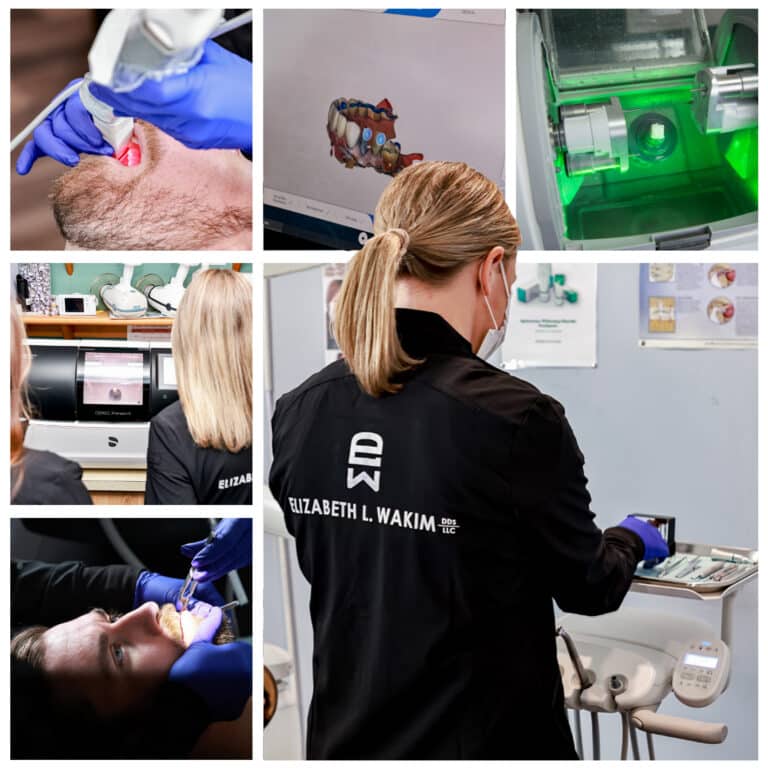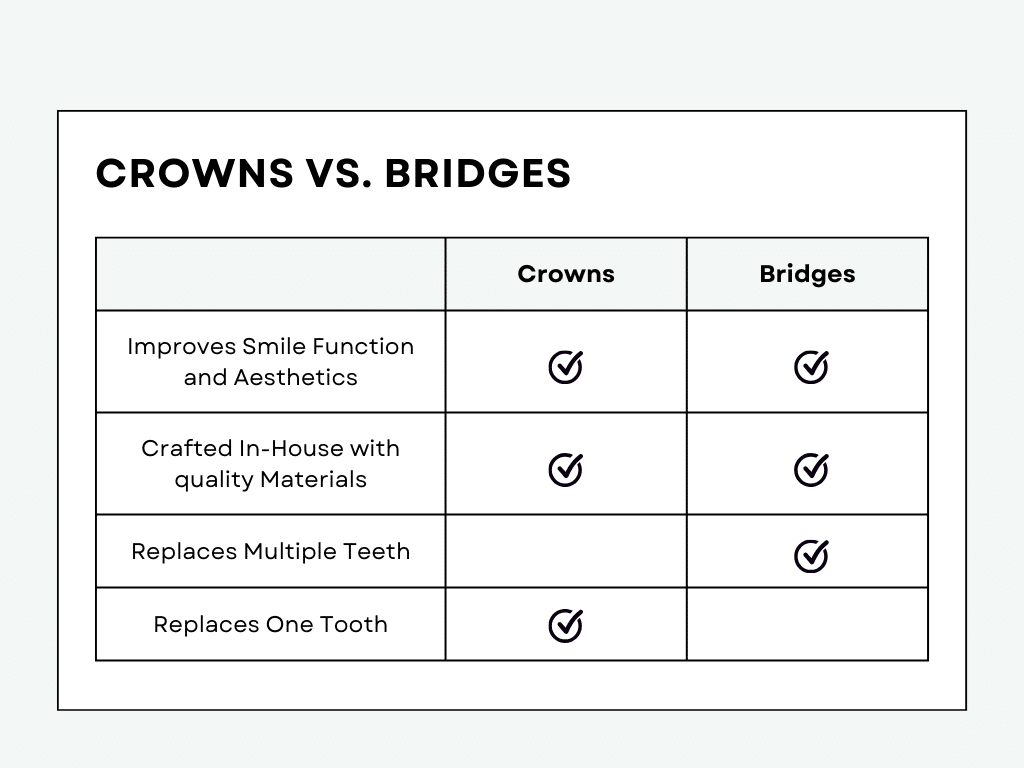
Root Canals
When Do I Need Root Canal Treatment?
If your tooth becomes inflamed, a root canal may be the right solution. Infection can happen when bacteria enters your tooth through a crack or deep cavity. If you experience any problems with a tooth filling, notice your gums swelling, or feel extra sensitivity while eating, it’s best to contact us right away.
The Treatment Process
If you need root canal therapy, don’t worry. The process is simple and only takes about an hour to complete. During the treatment, your dentist will carefully remove the infected part of your inner tooth called the dental pulp. Afterward, they’ll skillfully shape, fill, and seal your tooth to fortify it and promote healing. You should heal quickly, enjoying a healthy smile again in no time.
Crowns & Bridges
We offer same- day dentistry with CEREC technology, so you can get your restoration crafted in-house without long waiting periods. Crowns and bridges work together to replace one or multiple decayed or missing teeth. Crowns serve as anchors for bridges, allowing us to seamlessly restore multiple teeth at once.
Be Confident. Be Comfortable.
Replacing missing or damaged teeth might seem daunting, but our crown and bridge experts are here to help every step of the way. We offer a variety of comfortable options, and we will work with you to determine the best way to give you a beautiful smile you can’t wait to share with the world.
Dental crowns and bridges are two options for restoring missing teeth to improve dental appearance and function. Dr. Elizabeth Wakim specializes in providing patients with dental solutions that feel comfortable and look great.



Removable Prosthetics
Removable prosthetics are often known as dentures, and can replace a full arch of teeth (complete dentures), or a number of individual or grouped tooth spaces (partial dentures).
Find The Right Fit With Full Or Partial Dentures.
We believe that everybody should have a smile that they are proud of, and that means we’re dedicated to helping you find the dental solution that fits your unique needs.
As a trusted, top-rated dentist in Washington, PA, Elizabeth Wakim and her dedicated team can help you select from between partials, flexi-partials, full dentures, or temporary dentures.
Common Questions
The root canal is a pulp-filled cavity deep inside a tooth. Usually, this part of the tooth is well-protected, but sometimes dental trauma, extreme tooth decay, or a tooth fracture can allow harmful bacteria into the root canal and cause infection. If the tissue in your root canal is unhealthy, becomes infected or inflamed, or dies, it can cause a great deal of pain and discomfort.
To treat damaged or infected tissue in the root canal, your dentist will start by administering anesthesia to numb the affected area. She can then make a small opening in the tooth, which allows her to access the root canal with instruments called endodontic files. The endodontic files are used to clean the root canal of any unhealthy tissue and shape it to prevent further infection. A biocompatible material called gutta-percha is used to fill the canals, preventing further bacteria, food particles, and other debris from entering and causing damage to the tooth. With the root canal itself treated, your dentist will restore the affected tooth with a crown.
Thanks to modern anesthetics, having a root canal is typically a simple procedure and doesn’t cause much more discomfort than an ordinary cavity filling. After the procedure, your mouth may remain numb for a few hours as the anesthetic wears off. You may experience some discomfort as you regain sensation in the area, but for most people pain or swelling is minimal and can be managed with over the counter painkillers. Your dentist may also prescribe antibiotics to help prevent infection, especially if you have a condition—such as diabetes or a heart valve problem—that may delay the healing process.
A crown—sometimes referred to as a “cap”—is one of many solutions that can be used to restore damaged teeth. Dental crowns are typically recommended for patients who need tooth reconstruction following a root canal, have a tooth that is broken in such a way that it might interfere with other solutions (such as overlays), and patients who need to replace an old crown for functional or aesthetic reasons.
When scheduling a dental crown procedure, it’s extremely important to find a licensed dentist who is highly-skilled and delivers compassionate care. To place a dental crown, the dentist first removes a portion of the tooth structure—as well as any cracks, decay, or other damage—which allows the crown to be placed on the tooth.
Dental crowns are created prior to the patient procedure by a laboratory technician and can be crafted from a variety of materials. The type of crown you should get depends on your own preferences and your unique dental needs. At Elizabeth L. Wakim, DDS, we offer several options to help you customize your dental care, including:
- Ceramic crowns
- Zirconia crowns
Different types of crowns may work better for different people. For example, patients who grind or clench their teeth may find that durable Zirconia crowns are their best option, especially for crowns placed in the back of the mouth. By comparison, many patients select all ceramic crowns—like Emax Press—for crowns placed in the front of the mouth due to their natural appearance.
Your dentist can help you determine what type of crown best fits your needs. After your selection is made, your dentist will help you customize the shape and color of your crown to give it the most pleasing appearance possible.
Crowns and onlays are extremely similar in procedure, appearance, and cost. When you get an onlay, your dentist still begins by removing a portion of the tooth structure and any cracks, cavities, or damage. However, an onlay requires less of the tooth structure to be removed.
A crown falling off is considered a dental emergency, and you absolutely must make an appointment with your dentist to address it. If you are not in pain, you can purchase temporary dental cement over the counter at your local pharmacy to protect the tooth until your appointment. However, temporary cement is just that—a temporary solution. Because you aren’t able to properly clean and sterilize your tooth when you do a DIY fix, it is still important to have a licensed dentist provide a more permanent solution.
If you are experiencing pain, it’s important to see a dentist as quickly as possible.
Dental bridges are one of many solutions that can be used to address missing teeth. Bridges span the gap left behind when a tooth (or teeth) falls out or is extracted. They are attached to the teeth on either side of the gap via strong dental crowns, which ensures that the bridge is secure.
Much like dental crowns, dental bridges can be made from a variety of materials depending on your unique dental needs and preferences. At Elizabeth L. Wakim, DDS, we offer a variety of options, including:
- Ceramic bridges
- Zirconia bridges
We strive to make all bridges in office, which means patients can often leave with their permanent bridge at the end of their visit. For longer bridges, a permanent bridge may need to be manufactured in our lab. In these situations, a patient will leave their initial appointment with a temporary bridge and will need to schedule another appointment to have the permanent bridge placed.
Placing a crown or bridge typically requires at least two visits to the office.
During the first session, the dentist will focus on preparing the teeth to accommodate the crown or bridge. This involves removing a portion of the tooth structure to accommodate the crown as well as removing any cracked or damaged areas of the tooth. To place a dental bridge, the tooth on either side of the gap to be bridged must be prepped in this way. The dentist will also take an impression of the teeth during the first session so that a comfortable crown or bridge can be crafted. To protect the tooth or teeth between appointments, the dentist will also cover the prepared teeth using temporary dental cement.
The second session involves placing and permanently adhering the crown or bridge. Crowns and fixed bridges are attached to the teeth with a bonding adhesive. Removable bridges are placed using clips.
Leave damaged and missing teeth in the past and embrace a beautiful, confident smile. Crowns and bridges join forces to replace multiple missing teeth. Crowns act as stable anchors for the bridge, enabling us to efficiently restore multiple teeth simultaneously. What’s more, we provide same-day dentistry using CEREC technology, ensuring your restoration is crafted in-house without extended waiting periods.
If you are missing some (but not all) of your teeth, partial dentures can be used to fill in the gaps in your smile. Partial dentures are kept in position with plates or clips. By comparison, full dentures are designed to accommodate patients who are missing all of their teeth. Full dentures are typically held in place with adhesives, but they can also be secured with dental implant posts for improved comfort and fit.
Yes! Our office is happy to accommodate patients who need temporary dentures while they are waiting for another procedure, like dental implants. Temporary dentures are crafted with the same care and attention that our permanent dentures receive, so you can be sure that your temporary dentures will be an excellent and comfortable fit.
Adjusting to dentures can take some time, but most patients adjust within about 2 weeks. Typically, patients receiving partial dentures adjust to their dentures more quickly than patients with full dentures. To speed up the adjustment process, it’s important to wear your dentures as directed. Many patients find that reading out loud helps them get used to the feeling of wearing dentures.
Join The Family
We’d love to have you come in and be a part of our family. We’ll ensure that our compassion and sophistication in dental innovation leave you coming back for more.
